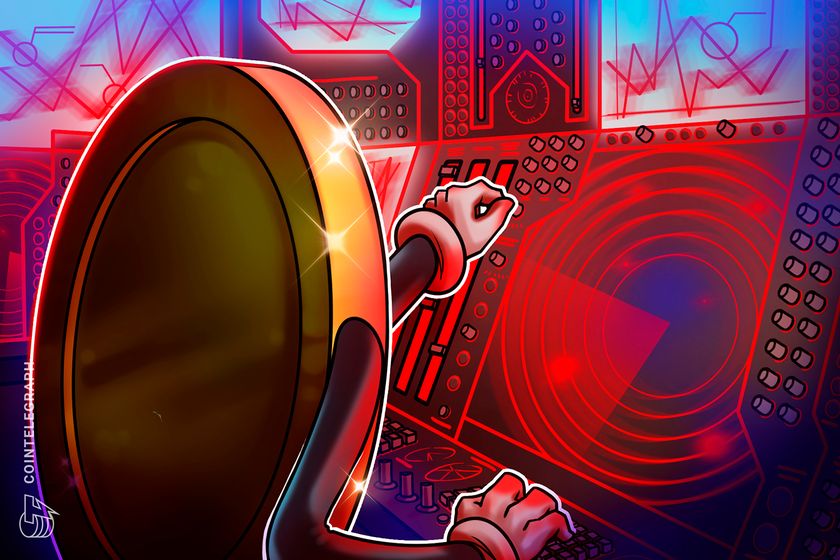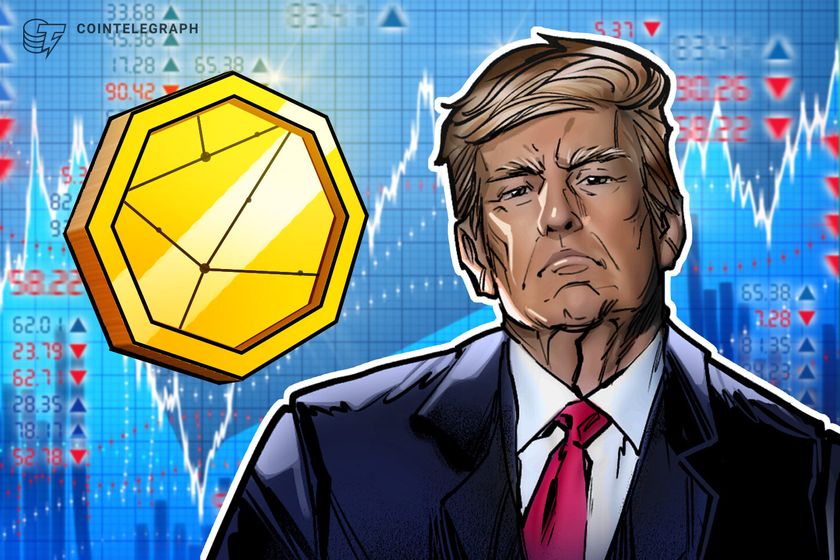Индекс страха и жадности
Топ 7 гейнеров
| Криптовалюта | Изменение за 24 часа |
|---|---|
| 13.59% | |
 TRON (trx) TRON (trx) | 3.55% |
 Binance Staked SOL (bnsol) Binance Staked SOL (bnsol) | 3.14% |
 Solana (sol) Solana (sol) | 2.86% |
 Pepe (pepe) Pepe (pepe) | 2.39% |
 Maker (mkr) Maker (mkr) | 1.6% |
 Algorand (algo) Algorand (algo) | 1.4% |
Топ 7 лузеров
| Криптовалюта | Изменение за 24 часа |
|---|---|
 Story (ip) Story (ip) | -5.52% |
 JasmyCoin (jasmy) JasmyCoin (jasmy) | -5.5% |
| -5.35% | |
 POL (ex-MATIC) (pol) POL (ex-MATIC) (pol) | -4.67% |
 Ethena (ena) Ethena (ena) | -4.57% |
 Stacks (stx) Stacks (stx) | -3.73% |
 Bittensor (tao) Bittensor (tao) | -3.62% |


Why some blockchains die
Blockchains can die from flawed tokenomics, scams, security issues or lack of community and development momentum. Without active participation, even cutting-edge technology gathers dust.
Ever heard of a blockchain that no one uses? It happens more often than you think. While the cryptocurrency space is full of innovation, but not every blockchain finds its tribe. Some are ghost towns with zero transactions, no developers and just a handful of holders stuck with worthless tokens. So, what makes a blockchain go quiet? And can they ever come back to life?

Not all blockchains are built to last. Some blockchains, like Bitcoin, Ethereum and Solana, have survived harsh market conditions, proving their resilience. Terra, however, plummeted from top-tier status to near oblivion in 2022 after its algorithmic stablecoin imploded.
Even well-intentioned projects can fail. Without ongoing development, user incentives or a strong community, blockchains can become unusable. Once the validators stop running nodes, the network effectively turns into a broken time capsule.
Blockchain adoption challenges in 2025
Blockchain adoption in 2025 still faces hurdles like unclear regulation, fragmented developer tooling, infrastructure gaps and the struggle to attract real users over bots despite some chains like Ethereum and Solana paving the way forward.
Regulatory uncertainty is one of the biggest roadblocks. Governments are still figuring out how to regulate crypto, and inconsistent or overly restrictive rules can strangle innovation before it takes root. Beyond policy, a thriving developer ecosystem is non-negotiable. Jumping between languages such as Solidity, Rust and Move-based systems demands versatility, and not every blockchain can lure the talent it needs to grow.
Then there’s the user problem — chains are overrun with bots chasing airdrops instead of real people engaging with the tech. Without authentic activity, a network’s bustling metrics are just smoke and mirrors.
Infrastructure is another major hurdle. Strong blockchains need robust tooling, high-quality remote procedure call (RPC) services and a decentralized validator set that ensures uptime and security. In the context of blockchains, RPC services refer to a mechanism that allows applications (like wallets, DApps or developer tools) to communicate with a blockchain network remotely.
On top of that, a thriving blockchain must rally a strong community of users, builders and commentators who genuinely believe in its long-term success.
Handling fear, uncertainty and doubt, or FUD, credibly is another test, especially when negative narratives arise; how a blockchain ecosystem responds can make or break trust. Keeping user loyalty while maintaining a sense of novelty is a delicate balance.
Ethereum has mastered this across multiple market cycles, evolving while retaining its core developer and user base. Since the FTX collapse in 2022, Solana has demonstrated resilience, overcoming reputational damage to rebuild its ecosystem, attract developers, and drive real usage through improvements in speed, efficiency and community support.
Did you know? Blockchain nodes expose RPC endpoints (often via HTTP or WebSocket protocols) that handle these requests. For example, when you use a decentralized app (DApp) on Ethereum, it might connect to an RPC service like Infura or Alchemy to fetch data or broadcast transactions.
What blockchains are still active in 2025?
As of April 2025, Ethereum, Solana, Bitcoin, BNB Chain, Polkadot, Near, Sui and Tron stand out as active blockchains, each excelling in distinct niches — DApps, speed, value storage, affordability, interoperability or scalability.
Active chains show daily user engagement, developer momentum and sustained transaction volume, while inactive ones become digital graveyards.
Not all blockchains are dead, but not all are thriving, either. Below are the insights into the standout survivors shaping the crypto landscape as of April 2025:
- Bitcoin: Bitcoin focuses on value storage, with a $1.636-trillion market capitalization on April 6, 2025, and regular transactions. The 2024 Bitcoin halving and approvals of exchange-traded funds (ETFs) keep it relevant. About 960 developers work on scalability, like Lightning Network, despite limited smart contract features.
- Ethereum: It powers decentralized finance (DeFi), non-fungible tokens (NFTs) and DApps, processing millions of daily transactions via layer 2s like Arbitrum as of April 2025. It had over 5,900 monthly active developers in June 2023. High total value locked (TVL) persists, though gas fees are a challenge without layer 2s.
- Solana: According to DefiLlama, Solana’s daily active addresses reached 3.68 million as of April 8, 2025. The surge is likely supported by its fast transactions and low fees. After the 2022 FTX dip, it recovered, supporting gaming and DeFi. It had over 1,400 developers in June 2023, with past outages noted as a concern. Also, the TRUMP token’s crash in March 2025, dropping over 85% from its January peak, strained Solana’s momentum.
- BNB Chain: Binance’s BNB Chain has 1.93 million daily users as of April 1, 2025, with affordable transactions. It shows notable TVL and volume, mainly in DeFi and gaming, though its centralized nature is debated.
- Polkadot: Polkadot connects blockchains, with over 1,900 developers in June 2023 working on interoperability. It supports multiple parachains, with moderate but growing activity as of April 2025, though it’s less accessible to casual users.
- Near Protocol: Near logs 3.18 million daily addresses as of April 1, 2025, using sharding for scalability. It supports DeFi and gaming, with developer tools aiding growth, but it’s still proving itself against larger chains.
- Sui: Sui, with 2.46 million daily users as of April 1, 2025, uses an object-oriented model for speed. Active in DeFi and gaming, it’s newer and lacks the ecosystem depth of older networks.
- Tron: Tron has 2.45 million daily addresses as of April 1, 2025, focusing on stablecoin transfers like Tether USDt (USDT). It handles high throughput but has limited DApp variety compared to others.
Inactive chains like EOS and Terra, impacted by governance or collapse, contrast with the above blockchains.
So, a blockchain’s success hinges on its daily activity. How many people are actually transacting on a blockchain every day? Are developers still building new DApps? Is there any meaningful transaction volume? If the answer to these questions is “not much,” the chain might be on its way to becoming a digital graveyard.
Did you know? According to Santiment, the top five Ethereum-based cryptocurrencies by development activity in March 2025 were Chainlink (LINK), Starknet (STRK), Ether (ETH), EigenLayer (EIGEN) and Fuel Network (FUEL). This ranking reflects the volume of development work, a key indicator of potential growth and innovation in the crypto market.
Blockchains that faded: What went wrong?
Blockchains like EOS and Terra teach us that hype isn’t enough. A blockchain needs real utility, trust and continuous innovation to survive.
Cases like EOS and Terra show that initial excitement isn’t enough to sustain a blockchain. Long-term survival seems tied to practical utility, trust and ongoing development rather than just hype.
Some blockchains started with potential but struggled to maintain traction. EOS, once called an “Ethereum killer,” raised $4 billion in its 2017 initial coin offering (ICO). By 2025, it saw minimal use, affected by governance challenges and low adoption.
Terra and its LUNA token faced a steeper drop in 2022 when its algorithmic stablecoin unraveled, erasing billions in value.
These examples suggest hype alone doesn’t ensure staying power — blockchains appear to need real use cases, solid security and active evolution.
Community often marks the divide between a blockchain that endures and one that fades. Ethereum has weathered multiple downturns, supported by a large developer base and active users. Developers building DApps draw in users, creating a cycle of growth. Validators and stakers enhance trust, boosting liquidity. Without this participation, even technically advanced chains struggle to remain relevant.
How to spot a living blockchain
Metrics like transaction volume, TVL, developer activity and validator count are essential signs of whether a blockchain is alive and trusted.
How can you tell if a blockchain is healthy? Transaction velocity and volume are major signs. A strong, active blockchain sees consistent transactions, while low activity is a red flag. Total value locked (TVL) is another critical metric because if DeFi users trust a chain, they’ll lock funds into its protocols. A declining TVL suggests that users are leaving.
Developer activity is also crucial. Are new projects launching? Is there ongoing development? A stagnant developer ecosystem often signals trouble. Validator and node count matter, too. A high number of validators shows decentralization and network security. And finally, liquidity and the onchain economy play a big role. If liquidity is drying up, so is the chain’s future.
Developers and founding teams move across blockchains if they can’t scale from where they are originally based. It comes with a cost, often to rebuild skills and user base. But multiple projects moving out of a chain can indicate a bearish trend for the chain, and vice versa could also be true.
For example, on April 3, 2025, the gaming project Infecteddotfun announced that it was shifting from Base to Solana due to scaling struggles. The project’s viral speculative simulation game drew 130,000 signups in 48 hours, overwhelming Base with transaction demand, spiking gas prices and halting gameplay. The team pointed to Ethereum Virtual Machine chain limitations, favoring Solana’s user-centric culture and robust user base.
What brings a blockchain back to life?
Inactive chains can return if they find compelling use cases, have a strong community, offer strong incentives, or evolve into new forms like layer-2 solutions.
So, can a dead blockchain come back to life? Sometimes. The key is finding a reason for people to return. A new use case can revive interest, especially if it solves a real problem. Protocol upgrades that improve scalability, fees or interoperability can also rekindle activity.
Strong incentives, such as grants, airdrops or liquidity rewards, can attract developers and users back to a network. In some cases, struggling projects pivot into layer-2 solutions or merge with more active ecosystems to stay relevant.
But most of all, a thriving community that has a high conviction on the future of a chain can lead to its resurgence from the worst. Solana’s rise from the FTX debacle due to a committed community is a case study in that respect.
The blockchain world moves fast. Some networks thrive, and some fade into obscurity. The ones that last are those with strong community support, real-world utility and continuous innovation. If a blockchain is silent today, it doesn’t mean it’s gone forever, but reviving it takes more than just wishful thinking.


Andrew Kang, founder of the crypto venture firm Mechanism Capital, has seemingly doubled down on his bet that Bitcoin will gain in price with a $200 million long position, onchain data shows.
“Andrew Kang just doubled his Bitcoin position,” crypto analytics firm Arkham said in an April 12 X post. It explained a crypto address tied to Kang made another $100 million long bet on Bitcoin (BTC) with an expected profit, or loss, of $6.8 million.
On April 9, Arkham noted that the Kang-tied wallet had put on a $100 million leverage-long bet on Bitcoin after US President Donald Trump posted to his Truth Social platform earlier the same day that “THIS IS A GREAT TIME TO BUY!!! DJT.”
Source: Arkham
Just hours later, the Trump administration announced a 90-day pause on its global hiked tariff regime, which sent crypto and stocks rallying. The tariffs, first unveiled on April 2, had gone live just hours earlier and had tanked most financial markets.
Kang said in an April 12 X post that trade war capitulation and a “Trump put” — the belief that the president will work to bump the stock market — “are the perfect combination for BTC to reverse a multi month downtrend.”
Kang noted Trump’s April 9 Truth Social post could be a sign of the so-called “Trump put.” Source: Andrew Kang
Meanwhile, Senate Democrats called on the Securities and Exchange Commission in an April 11 letter to launch an insider trading and market manipulation probe into Trump and his affiliates over the post, which they said “appears to have previewed his plans” to pause the tariffs.
Bitcoin choppy on tariff confusion
Bitcoin has seen an over 2% swing over the past 24 hours as the Trump administration went back and forth on tariff exemptions for Chinese electronic goods.
Related: NFT trader faces prison for $13M tax fraud on CryptoPunk profits
Bitcoin hit a 24-hour low of $83,197, wiping most of the gains it made before the weekend, but it has since recovered to trade flat over the past day at around $85,000 after briefly hitting a top of $85,315, CoinGecko data shows.
Trump posted to Truth Social on April 13 that “there was no tariff ‘exception’ announced on Friday,” April 11, but that levies on Chinese electronics are “moving to a different Tariff ‘bucket’” of 20%.
Asia Express: Bitcoiner sex trap extortion? BTS firm’s blockchain disaster


The team behind real-world tokenized asset blockchain Mantra says its native token’s sudden 90% plunge was caused by exchanges forcibly closing positions without notice, with one currently unnamed exchange potentially to blame.
On April 13, Mantra (OM) price dropped from $6.30 to below $0.50, rapidly shedding over 90% of its $6 billion market cap.
“We have determined that the OM market movements were triggered by reckless forced closures initiated by centralized exchanges on OM account holders,” Mantra co-founder John Mullin wrote in an April 13 statement on X.
“The timing and depth of the crash suggest that a very sudden closure of account positions was initiated without sufficient warning or notice,” he added.
Source: John Mullin
“That this happened during low-liquidity hours on a Sunday evening UTC, early morning Asia time, points to a degree of negligence at best, or possibly intentional market positioning taken by centralized exchanges.”
Mullin told an X user they believe one exchange “in particular” was to blame but said they were still “figuring out the details.” He told others that the centralized exchange in question wasn’t Binance.
Mantra has an upcoming community connect on X, where Mullin says the team would share more information.
Source: John Mullin
Some traders allege the token collapse was a rug pull, while others are speculating the Mantra team had used their tokens as collateral to take out a massive loan from a centralized exchange and the team fell prey to a loan risk parameter change, then a margin call.
Mullin denied these theories in follow-up X posts, saying, “The team did not have a loan outstanding” and haven't orchestrated a rug pull.
“Tokens remain locked and subject to the published vesting periods. OM’s tokenomics remain intact, as shared last week in our latest token report. Our token wallet addresses are online and visible,” Mullin said.
Source: John Mullin
The price of OM staged a minor recovery in the aftermath of the price collapse, briefly returning above $1, but it is back down and currently trading around $0.7894, according to CoinGecko.
The token hit an all-time high of just under $9 on Feb. 23 and is now down over 91% from that figure.
Source: Star Xu
Millions of Mantra tokens moved in the week prior to collapse
Blockchain analytics platform Spot On Chain said in an April 14 post to X that some OM whales moved 14.27 million tokens to the crypto exchange OKX three days before the crash. In March, the same whales picked up 84.15 million OM for $564.7 million.
“Now, after a brutal 90% drop, their remaining 69.08 million OM is worth just $62.2 million, putting their total estimated loss at a staggering $406.3 million,” Spot On Chain said.
“However, they may have hedged the position elsewhere, and it’s possible they contributed to the sharp drop.”
Source: Spot On Chain
At the same time, blockchain analytics platform Lookonchain said that since April 7, at least 17 wallets deposited 43.6 million OM into crypto exchanges, representing 4.5% of the circulating supply.
Related: Mantra unveils $108M fund to back real-world asset tokenization, DeFi
In January 2025, Mantra and investment conglomerate DAMAC signed a $1 billion deal to tokenize the investment conglomerate’s various assets.
Meanwhile, Mantra announced on Feb. 19 that it had received a virtual asset service provider license from Dubai’s Virtual Assets Regulatory Authority.
Magazine: Illegal arcade disguised as … a fake Bitcoin mine? Soldier scams in China: Asia Express


Crypto markets have been fairly stable amid wider market panic caused by US President Donald Trump’s “on-again, off-again” sweeping global tariffs, according to a New York Digital Investment Group (NYDIG) analyst.
“Despite the carnage in traditional financial markets, the crypto markets have been relatively orderly,” NYDIG global head of research Greg Cipolaro said in an April 11 note. “Historically, in broad risk-off moves, we tend to see stresses show up in crypto markets. We have yet to see that.”
Cipolaro said crypto perpetual futures rates have “been persistently positive,” with liquidations spiking on April 6 and 7 in the days after Trump first announced the tariffs on April 2 but only to a total of $480 million, which he added “was well below other notable liquidation events.”
He noted that the price of Tether (USDT), a US dollar-tracking stablecoin widely used token in crypto trading, was below $1 but had “not experienced a sharp decline.”
Trump unveiled a sweeping tariff regime on April 2 that lumped various levies on every country before pausing them for 90 days just hours after they came into effect on April 5 and instead charging a base tariff of 10%, besides China, which currently has tariffs of up to 145%.
Traditional and crypto markets tanked after Trump’s April 2 tariff announcement, and many assets haven’t recovered to the same level as before their unveiling.
Stocks, bonds and foreign exchange volatility rates all rose after Trump’s tariffs announcement. Source: NYDIG
Over the weekend, the Trump administration caused more confusion with its tariffs, saying on April 13 that an April 11 decision to exempt many electronics from tariffs was temporary and they would still be hit with levies.
Bitcoin fares well, declining volatility to make it widely attractive
Cipolaro said that Bitcoin (BTC) didn’t escape the market volatility, “but at current prices has fared far better than many other asset classes.”
He added that Bitcoin’s volatility hasn’t risen to historic levels, unlike the traditional markets, and “has been relatively stable” despite instability instigated by the Trump administration.
“Perhaps investors are increasingly searching for stores of value not tied to sovereign countries and thus not affected by the trade turmoil.”
Bitcoin is down 22.5% from its mid-January peak of over $108,000 and has traded flat over the past 24 hours at $84,730, according to CoinGecko.
Cipolaro said the narrowing gap between Bitcoin’s volatility and other assets makes it “increasingly more appealing” to funds with risk parity portfolios — those that use risk to choose asset allocations.
He added that investors are likely reducing their risk exposure but “perhaps some reallocation of asset mix to Bitcoin is one of the reasons it has been more buoyant.”
Related: S&P 500 briefly sees ‘Bitcoin-level’ volatility amid Trump tariff war
“Risk parity funds allocating to Bitcoin can help dampen its volatility — making the asset more attractive and potentially reinforcing a virtuous cycle of increased adoption and stability,” Cipolaro said.
However, YouHodler chief of markets Ruslan Lienkha told Cointelegraph in an April 12 note that despite a wider market rebound, “technical indicators are painting a concerning picture.”
He said a “death cross,” when the 50-day moving average crosses below the 200-day moving average, is potentially forming on Bitcoin and the S&P 500.
Lienkha said the pattern is “generally considered a bearish signal for the medium term, suggesting that markets may struggle to sustain upward momentum without a clear catalyst or a stream of positive macroeconomic developments.”
Magazine: Financial nihilism in crypto is over — It’s time to dream big again


Ethereum co-founder Vitalik Buterin argues it’s Ethereum’s application layer, not its infrastructure layer, where Ethereum needs “good social philosophy” the most.
The app layer is where developers build decentralized applications on top of Ethereum’s base infrastructure and where they make decisions about how these programs operate.
In an April 12 post on the social media platform Warpcast, Buterin responded to a user’s argument that Ethereum needs a new generation of developers rooted in Ethereum’s core values to renew itself. He argued that it’s the app layer that needs this more.
“Apps are 80% special purpose. What apps you build depends heavily on what ideas you have of what Ethereum apps, and Ethereum as a whole, are there to do for the world. And so having good ideas on this topic out there becomes crucially important,” Buterin said.
Source: Vitalik Buterin
In comparison, Buterin says a programming language like C++ may not be as influenced by the creator’s ideology, as it is a general-purpose tool that doesn’t have much surface to be made worse or improved by social philosophy.
“Imagine that C++ had been made by a totalitarian racist fascist. Would it be a worse language? Probably not,” he said.
Ethereum’s layer 1 is similar to an extent, argued Buterin, though it is more exposed to philosophical influence, citing its move to proof-of-stake (PoS) and supporting light clients as examples.
“Someone who doesn’t believe in decentralization would not add light clients, or good forms of account abstraction,” he said.
“Someone who doesn’t mind energy waste would not spend half a decade moving to PoS, but the Ethereum Virtual Machine opcodes might have been roughly the same either way. So Ethereum is perhaps 50% general-purpose,” Buterin added.
Apps with good social philosophy vs bad
In a follow-up post, Buterin told a user that in his opinion, crypto privacy protocol Railgun, Web3 social protocol Farcaster, decentralized prediction market Polymarket and messenger app Signal are examples of apps with a good social philosophy.
Source: Vitalik Buterin
“You build apps that do the right thing behind the scenes by default. Signal is a reasonably good example of this, though it has significant flaws of its own. Farcaster is also a good example of this,” Buterin said.
Related: Vitalik Buterin criticizes crypto’s moral shift toward gambling
On the other hand, Buterin said the memecoin platform Pump.fun, the collapsed crypto ecosystem Terra, its native token Terra (LUNA), and the collapsed crypto exchange FTX are examples of bad social philosophy.
“The differences in what the app does stem from differences in beliefs in developers’ heads about what they are here to accomplish,” he said.
Magazine: Bitcoin eyes $100K by June, Shaq to settle NFT lawsuit, and more: Hodler’s Digest, April 6 – 12


The Trump family-backed crypto project World Liberty Financial (WLFI) has added 4.89 million SEI tokens valued at $775,000 to its portfolio, according to onchain data.
Data from blockchain analytics firm Arkham Intelligence shows the purchase was made on April 12 by one of WLFI’s trading wallets using USDC transferred from the project’s main wallet. It’s the same trading wallet previously used by WLFI to accumulate other altcoins.
WLFI holds a diversified portfolio, including Bitcoin (BTC), Ether (ETH), and a larger number of altcoins, such as Tron (TRX), Ondo Finance (ONDO), Avalanche (AVAX) and now Sei (SEI).
According to blockchain researcher Lookonchain, WLFI has spent a total of $346.8 million accumulating 11 different tokens, but as of April 12, it has yet to see a profit on any of them. The project’s Ethereum investments alone are currently down over $114 million.
Overall, Lookonchain says WLFI’s portfolio is down $145.8 million.
World Liberty Financial’s current on-paper profit/loss on its altcoins. Source: Lookonchain
Only two months ago, in a Feb. 3 X post, Donald Trump’s son, Eric Trump, urged his followers to buy Ether, writing: “In my opinion, it’s a great time to add $ETH.” Originally, the tweet also included “you can thank me later,” but it was edited to remove those five words.
At the time of writing, data from CoinGecko showed ETH’s price had fallen 55% since Eric Trump’s tweet, currently trading at $1,611, down from the Feb. 3 close of $2,879.
Related: Democrats slam DOJ’s ‘grave mistake’ in disbanding crypto crime unit
WLFI’s USD1 logo appears on major exchanges
Meanwhile, an icon for WLFI’s stablecoin, USD1, has appeared on Coinbase, Binance and the crypto aggregator website CoinMarketCap in what appears to be the coin’s unofficial logo unveiling.
WLFI has made no official announcement about USD1’s logo.
Observers speculate this is USD1’s new logo. Source: Binance
Trump’s involvement with USD1 has attracted criticism from lawmakers on both sides of US politics. At an April 2 US House Financial Services Committee hearing on stablecoin legislation, Democratic Representative Maxine Waters suggested President Trump may be ultimately planning to use USD1 to replace the US dollar.
“Trump likely wants the entire government to use stablecoins, from payments made by the Department of Housing and Urban Development to Social Security payments to paying taxes. And which coin do you think Trump would replace the dollar with? His own, of course.”
The committee’s Republican chair, French Hill, aired similar concerns.
“If there is no effort to block the president of the United States of America from owning his stablecoin business [...] I will never be able to agree on supporting this bill, and I would ask other members not to be enablers.”
Magazines: 3 reasons Ethereum could turn a corner: Kain Warwick, X Hall of Flame


Commerce Secretary Howard Lutnick walked back the recent reciprocal tariff exemption on select electronics announced in an April 12 bulletin from the United States Customs and Border Protection.
On April 13, Lutnick told ABC News that the reciprocal tariff exemption was temporary until the administration established a sector tariff regime for semiconductor products, which includes phones, graphics processors, and computing chips in a "month or two." Lutnick added:
"President Trump has called out pharmaceuticals, semiconductors, and autos. He called them sector tariffs, and those are not available for negotiation. They are just going to be part of making sure we ensure core national security items are made in this country."
"We can't be relying on China for fundamental things we need. Our medicines and our semiconductors need to be built in America," Lutnick continued. The official also said he was confident that the US and China would arrive at a trade deal through negotiations.
The emphasis on national security and onshoring critical industries could signal that the trade tariffs will be a long-term geostrategic policy and not simply a short-term negotiation tactic to make US exports more attractive, as some analysts have suggested.
The Volatility S&P Index (VIX), a measure of the S&P stock index’s volatility, remains elevated amid macroeconomic uncertainty. Source: TradingView
Related: Bitcoin ‘decouples,’ stocks lose $3.5T amid Trump tariff war and Fed warning of ‘higher inflation’
Trade war heightens volatility and sends markets tumbling
Trump's trade tariffs crashed the stock and crypto markets, wiping away trillions in shareholder value as investors dumped riskier assets on fears of a lengthy trade war between the United States and its trading partners.
In an April 10 X Post, Bloomberg analyst Eric Balchunas cited the SPY US Equity History Volume chart as evidence that the S&P 500 stock market index is now more volatile than Bitcoin (BTC).
According to the analyst, the S&P 500 Index hit a volatility level of 74 in April, compared to Bitcoin's 71.
Stocks and crypto pumped following rumors of the Trump administration initiating a 90-day reciprocal tariff pause. Approximately $2 trillion was pumped into stocks on rumors of softer trade policies.
Much of this value was then wiped away when Trump claimed that rumors of a 90-day pause were false and returned once the Trump administration did, in fact, issue a reciprocal tariff pause in the following days.
Magazine: Financial nihilism in crypto is over — It’s time to dream big again
Крупные Транзакции
| Криптовалюта | Отправитель | Получатель | Сумма (USD) | Когда |
|---|---|---|---|---|
| Unknown | Unknown | $1015069.8 | менее минуты назад | |
| Unknown | Unknown | $2016730.4 | 1 минута назад | |
| Unknown | Unknown | $2520913 | 1 минута назад | |
| Unknown | Unknown | $1044074.75 | 1 минута назад | |
| Unknown | Unknown | $1524903.4 | 1 минута назад | |
| Unknown | Unknown | $1941472.2 | 1 минута назад | |
| Unknown | Unknown | $3007524.8 | 1 минута назад | |
| Unknown | Unknown | $1038900.3 | 2 минуты назад |
Крупные экономические события на сегодня
| Время | Событие | Страна |
|---|---|---|
| 20:00:00 | Сальдо торгового баланса | Новая Зеландия |
| 23:30:00 | Недельные запасы сырой нефти по данным Американского института нефти (API) | Соединенные Штаты |
| 20:00:00 | Сальдо торгового баланса | Новая Зеландия |
| 19:00:00 | Председатель ЕЦБ Лагард выступит с речью | Еврозона |
| 15:30:00 | Объём продаж в производственном секторе | Канада |
| 15:30:00 | Индекс потребительских цен (ИПЦ) | Канада |
| 15:30:00 | Базовый индекс потребительских цен (ИПЦ) | Канада |
| 15:30:00 | Индекс производственной активности NY Empire State | Соединенные Штаты |
| 15:30:00 | Индекс цен на импорт | Соединенные Штаты |
| 15:30:00 | Индекс цен на экспорт | Соединенные Штаты |
| 15:15:00 | Объём строительства новых домов | Канада |
| 15:00:00 | Индекс цен от GlobalDairyTrade | Новая Зеландия |
| 14:00:00 | Индекс инфляции IGP-10 | Бразилия |
| 13:30:00 | Индекс потребительских цен (ИПЦ) | Индия |
| 12:00:00 | Индекс экономических настроений от ZEW | Еврозона |
| 12:00:00 | Объём промышленного производства | Еврозона |
| 12:00:00 | Индекс экономических настроений ZEW в Германии | Германия |
| 12:00:00 | Индекс текущих экономических условий ZEW в Германии | Германия |
| 11:00:00 | Ежемесячный отчет МЭА | Соединенные Штаты |
| 11:00:00 | Бюджетный баланс | Турция |
| 11:00:00 | Индекс потребительских цен (ИПЦ) | Польша |
| 09:45:00 | Гармонизированный индекс потребительских цен Франции | Франция |
| 09:45:00 | Индекс потребительских цен (ИПЦ) Франции | Франция |
| 09:30:00 | Индекс оптовых цен | Индия |
| 09:00:00 | Уровень безработицы | Великобритания |
| 09:00:00 | Изменение занятости, 3м/3м | Великобритания |
| 09:00:00 | Изменение числа заявок на пособие по безработице | Великобритания |
| 09:00:00 | Средний уровень заработной платы с учетом премий | Великобритания |
| 04:30:00 | Протокол заседания по кредитно-денежной политике | Австралия |